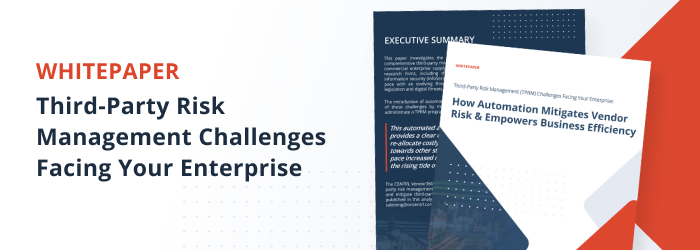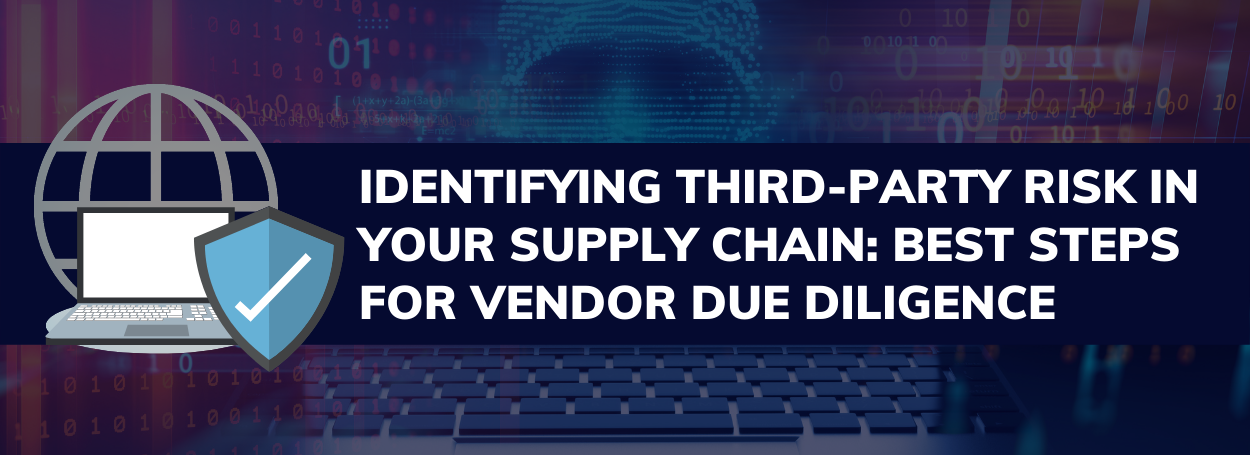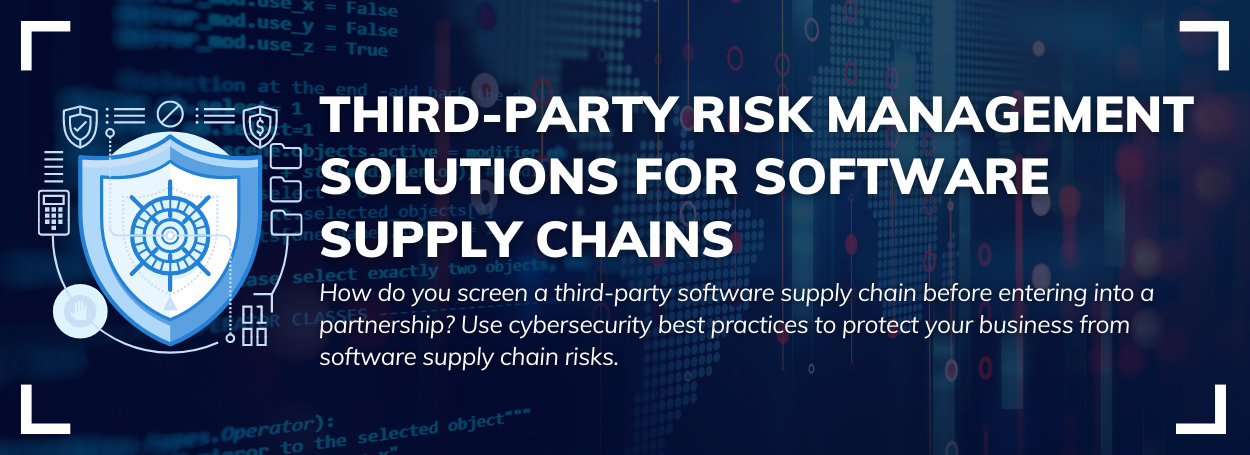Comprehensive Guide to Third-Party Vendor Risk Management
Introduction
Third-party vendors are an indispensable part of most businesses as they provide them with a competitive edge by spurring growth, boosting productivity, and cutting costs. While outsourcing offers many advantages, it comes with an array of risks.
With the excessive dependence of organizations on third parties, the frequency and severity of data breaches, legal and compliance issues, and reputational damages have increased. As such, businesses need to rethink their approach towards managing vendor risks.
Many businesses avoid expanding their supplier ecosystem for fear of the increased risks that can come along. These businesses eventually get overshadowed by competitors that stay on their growth trajectory while using robust vendor risk management programs.
Vendor risk management (VRM) is unavoidable for any organization that works with third parties. VRM is a multiplex set of processes that can help your organization identify, assess, monitor, and mitigate risks emanating from your entire vendor ecosystem.
But how do you go about designing and executing a third-party vendor risk management program? This guide has you covered.
Follow the steps explained in this guide to develop and implement a robust VRM program in your organization.
We have designed this guide for cyber risk assessment consultants and compliance officers. The information contained in this guide is current and expert-vetted. It revolves around the identification, monitoring, remediation, and resolution of vendor risks.
We recommend reading this guide from the start to the end. We’ve also thrown many valuable links throughout this guide to provide you with in-depth insights into relevant areas.
In the event that you feel exhausted by the complex VRM processes, buck up: there’s a powerful software to automate most of the VRM processes.
What is Vendor Risk Management and Why is it Important
Vendor risk management (VRM) comprises activities involved in identifying, assessing, controlling, and mitigating the risks of third-party vendor and supplier relationships. It also involves applying due diligence to select and onboard new suppliers, vendors, and service providers.
The due diligence process involves investigating, vetting, and reviewing your potential and existing vendors to determine if they’re safe and suitable for having business relationships. It is a continuous process that involves audits, reviews, and communications throughout the supplier lifecycle.
Third-party vendor risk management plays a crucial role in preventing data breaches and reducing the otherwise costly damages that can result from supply chain attacks. While vendor risk management is not a new discipline, the levels and types of risks keep evolving.
Businesses are now faced with newer and sophisticated vendor risks that, if not managed properly, can trigger stringent regulatory penalties, legal troubles, and reputational damages.
Organizations must make VRM a board-level topic. The top management teams must understand the consequences of third-party data breaches. Also, no matter your company’s risk profile, VRM is crucial for internal audit, control, and risk mitigation.
Difference Between Vendor Risk and Third-Party Risk
Many people assume that vendor risk and third-party risk are the same, which is why they often use the terms interchangeably. The truth is that there is a narrow difference between the two.
Vendor risks are the threats posed to your organization from entities within the supply chain. For example, risks posed by external entities that provide your business with software, IT solutions, and goods and services are vendor risks. These could include your database developer, cloud service provider, website hosting service, payment processing company, and raw material supplier.
On the other hand, third-party risks include all the risks posed to your business by the entities mentioned above; plus, it covers the dangers coming from other stakeholders. These other stakeholders could be your customers, joint-ventures, partner organizations, regulatory bodies, data and privacy laws (such as GDPR), and more.
While these additional third-party entities don’t directly provide your business with any goods or services, they can still expose you to serious risks because they’re connected to your organization in one way or another.
Though most organizations choose vendor risk management (VRM), others prefer all-inclusive third-party risk management (TPRM). Let’s have a look at the difference between VRM and TPRM.
VRM Vs. TPRM
The VRM process includes due diligence tasks before selecting and onboarding a vendor. Most VRM programs use questionnaires and surveys to collect data from potential vendors. You can then use the collected data to determine whether the prospective vendor follows the essential regulatory and industry standards and has reliable cyber defenses in place.
Another key component of the VRM program is risk assessment. This may involve analyzing your vendors’ risk management procedures, data security, and compliance programs. For example, you could ask your vendors for sureties like audit reports, compliance certifications, penetration testing evidence, etc.
VRM is not a one-off undertaking. It is a continuous process to identify, monitor, and manage the risks throughout the vendor relationship and, in many cases, even after the end of the relationship.
When it comes to TPRM, it involves all of the activities of the VRM, but with one limitation: you can select your vendors, but you cannot choose your third-party stakeholders. For instance, you don’t have control over selecting your clients and regulatory organizations. As such, TPRM does not offer you the supremacy to control many of the risks emanating from your non-supplier third-party entities.
Steps to Develop a Vendor Risk Management Program
The success of a vendor risk management program depends heavily on thorough planning, extensive monitoring, and unrelenting due diligence in every stage of the process.
Broadly, vendor risk management programs comprise five main steps:
1. Policy Documents and Procedures
Well-defined policies and procedures lay down the foundation for an effective VRM program. Policies outline a high-level overview of the appropriate approach to vendor risk management.
On the other hand, procedures define the roles and functions of the people involved in the VRM program, including senior management.
In effect, these documents serve as guidelines detailing the proper steps, measures, and strategies that a firm should take to contain vendor risks to acceptable levels.
2. Vendor Onboarding Rigor
Vendor onboarding is an undertaking that can expose an organization to serious risks if not executed with stringent regard to due diligence. The policy and procedure documents will first come into play here, as those will define the risk assessment and audit approach you will take.
The vetting and audit process can include penetration testing, site visits, and comparing risk scores of different vendors.
Also, rigor is critical in the vendor selection process. Proper vendor selections can significantly reduce the likelihood of risk emergence in later stages.
3. Vendor Contract Standards
There is no one-size-fits-all contractual template for your entire network of vendors. Every new vendor relationship will present unique considerations that may not always fit within a prescribed template. The roles, responsibilities, and compliance requirements generally vary from vendor to vendor. It is essential to have sufficient flexibility in contracts to allow for these variations.
That said, there should be uniformity in the standards of procedures for negotiation, vetting, and approval. And you need a clearly communicated approach to contract storage and monitoring for changes in key terms and conditions. Other vital standards that any vendor contract should contain are security documentation, service level agreements, procedures for issue escalation, and vendor termination.
4. Continual Vendor Risk Monitoring
Ongoing risk assessments are vital to a successful vendor risk management program. Often, firms display a reasonably high commitment to due diligence until the vendor onboarding process but soften up during subsequent stages of the risk management process.
This is, of course, a mistake. All vendors exist in a vast ecosystem that is subject to constant changes. Even the most rigorous vetting during vendor selection can amount to nothing if firms forgo due diligence later on.
Continual monitoring commonly involves:
- Reviewing vendors’ financial statements. A decline in financial standing may indicate higher levels of vendor risks.
- Period evaluation of the vendor’s information/cybersecurity safeguards, SOC reports, evidence of compliance with privacy and ethical frameworks, and disaster recovery plans.
- Annual assessments of vendor risk, performance, and information security, and updating risk scores accordingly.
In short, due diligence is not a one-time occurrence that firms have to get out of their way at the start of a vendor risk management program. Instead, it is a permanent and continuous process that underlies any successful risk management strategy.
5. Internal Audits and Examination
Internal audits naturally become more manageable when you’ve successfully applied due diligence to all the earlier mentioned steps. With the results of the vendor assessments, it makes sense to perform a re-evaluation of your vendor relationships.
If you can identify and address risks before an external examiner does, it enables you to pass audits. On top of that, it also provides well-deserved reassurance of your firm’s risk management capabilities.
Common Types of Third-Party Risks
There are many distinct types of risks that relationships with third-party vendors can expose an organization to:
Operational risk: Vendors that support your day-to-day operational activities pose a risk of disruptions if they pull out or suffer a security breach.
Transactional risk: Payments that are processed through third-party sources can prove costly if disrupted.
Strategic risk: A vendor that fails to provide growth opportunities that you expected can hurt your business on a strategic level.
Credit risk: Third-parties prone to defaulting on their agreements or payments are risks to your business’ finances.
Reputation risk: Disruptions that impact your customers can mean damage to your company’s reputation.
Legal risk: Exposure to legal risks comes in the form of vendors plunging into lawsuits and incurring legal expenses.
Country risk: The negative impact of economic and political forces on your foreign vendors can increase your risks.
Compliance risk: Failure of a vendor to comply with regulatory frameworks could lead to regulators holding you accountable.
Cybersecurity risk: IT vulnerabilities in a vendor’s system could serve as gateways of attacks on your systems.
Cloud risk: Cybercriminals can use compromised cloud storage to steal your data.
Vendor concentration risk: Services or products primarily sourced from one or a few suppliers can increase business continuity risks.
You Are Responsible for Your Vendor Risks
On paper, every third-party vendor, supplier, and outsourcer you come in contact with is accountable for their own failures in compliance, cybersecurity threats, financial upsets, legal problems, and operational resilience.
Unfortunately, the realities of the practical world are harsh and often unfair. It is the contracting entity, i.e., your business, that will be taken to task and endure damages should any one of your vendors undergo a security breach or show negligence in compliance.
This is the plain reason why due diligence in every step of vendor risk management, from pre-contract assessments, onboarding, and continual monitoring to internal audits, is imperative for operational resilience in the face of macro-level disruptions.
While the responsibilities on your shoulders as a contracting entity are great, so are the rewards if your VRM program can withstand the tests. After all, that is how great organizations secure lasting competitive advantage.
How to Analyze Third-Party Risks
Analyzing third-party risks involves a thorough understanding of the vendors in your network. And this understanding is built on the basis of vendor-related data that you acquire as per a defined vendor management policy. The policy framework contextualizes your entire third-party risk assessment program, from vendor onboarding to monitoring.
The quality and accuracy of analysis heavily depend on the guidelines outlined in the policy framework. These include policies pertaining to the tools, data, personnel, and other resources a firm will need to undertake the analysis.
Here are some of the key considerations to undertake an effective third-party risk analysis:
- Documents: A lot of paperwork and documentation go into vendor risk assessment. The framework should specify each document that you’ll require to conduct a thorough assessment.
- The number of personnel: It’s important to have a team of personnel entirely devoted to assessing third-party vendor risks. Specifying these numbers in your framework can help initiate the assessment lifecycle with maximum efficiency. It’s also important to ensure situation-based flexibility to allow for changes in the number of personnel, depending on how your risk management program evolves.
- Approach and methods: Depending on the guidelines and systems in place, some risk management approaches may be a better fit for your particular business. For instance, continuing the use of manual, spreadsheet-based risk evaluation workflows could be inefficient when your organization is technologically ready to transition to automated tools.
- Compliance with frameworks: Demanding compliance with security frameworks is essential to mitigating cybersecurity risks. Clearly outlining those frameworks for which compliance is non-negotiable can help weed out vendors that are likely to expose your business to higher risks.
- Frequency of assessments: Ongoing evaluations are crucial features of a proactive risk management program. Maintaining high frequency can be challenging and cost-prohibitive, especially if you lack the essential technological readiness. Finding that balance between a reasonable periodicity of assessments without becoming too onerous is imperative.
- The degree of risk tolerance: Understand the degree of risk tolerance by evaluating the maximum severity of a risk that your business can reasonably withstand. All risk management activities are meant to be a concerted effort for containing risks under the threshold of tolerance.
- Managing identified risks: Finally, every comprehensive risk management program is marked by a clear understanding of situations in which a risk may be accepted and situations in which the risk will warrant mitigative action. Guidelines for managing risks as they occur in real-time due to changes in the vendor’s circumstances are also a key component of a well-defined risk analysis framework.
Steps to Conduct Vendor Risk Assessment
The general steps involved in an extensive vendor risk assessment framework are explained below. Most of these steps can today be automated with specialized tools, but the nitty-gritty of the procedure remains the same:
1. Surveys for Vendor Onboarding
Onboarding a new vendor is always a risky undertaking. This is a step where the smallest of negligence can have a serious impact on your firm later on.
The standard practice of well-rounded risk assessment programs involves the utilization of survey questionnaires, such as SIG to obtain key information regarding your vendors.
Modern automated tools make this step extremely easy with pre-built surveys that you can deploy to extract the necessary information from hundreds of vendors at the same time.
2. Risk Identification
Third-party risks can emanate from all sorts of directions. Commonly, it’s advisable to be especially wary of process risks, contract risks, cybersecurity risks, legal risks, business continuity risks, and political risks.
Make sure to identify the kind of risk each vendor poses for a better understanding of the foreseeable consequences that getting into a contract with a new vendor may have for your business.
3. Vendor Classification and Risk Segmentation
Based on the type and severity of risks associated with each vendor, segment and categorize your vendors into different groups.
Grouping your vendors will provide you a 360-degree view of your vendor ecosystem. You will also get a clear picture of the various types of risks your business faces from each vendor segment.
Once you’ve identified the third-party risks to your organization, you can prepare to cope with those risks. Vendor classification will help you manage and navigate the risks emanating from vendors in each category.
4. Perform Assessments
It is always a good idea to visit vendor facilities to conduct on-site audits. Consider the importance that your relationship with a given vendor holds for your business. And based on the significance of the association, define the roles and responsibilities of the vendor if any risk threatens your business.
5. Continuous Monitoring and Periodic Assessments
Periodic risk assessments keep you informed about any changes that might occur in relation to the vendor, your organization, or the wider supplier ecosystem. When necessary, update standards, frameworks, and regulations in light of these changes.
Automate Your VRM Process
The stages and steps of a VRM process can quickly become cumbersome and difficult to manage if performed manually. The good news is that you can boost your efficiency at minimal costs by automating the VRM process.
CENTRL’s Vender360 is a comprehensive, next-generation VRM software that allows you to automate many cumbersome functions and steps in the VRM process. Manage a whole network of vendors at the same time without sacrificing the precision and rigor that any robust VRM process must possess.
Learn more about the Vender360 and its plentiful features, or see the tool in action with a LIVE Demo today.



